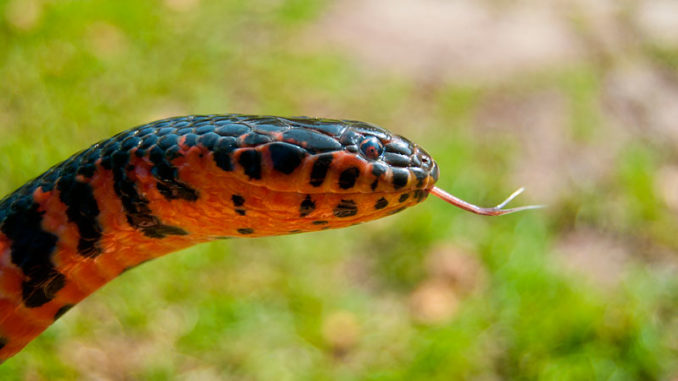
“Perception is based on many things, but not least your expectations. Lose them and you’ll see things differently.” –Unknown.
This is Kevin Hood with the Louisiana Snake ID Facebook page back to share more information about our native snakes in Louisiana. Our goal is to offer knowledge that can bring your expectations about snakes in line with the truth and hopefully shift the perspective that snakes are inherently “evil.”
Out of the 48 species that live in Louisiana, we’ve looked at the seven venomous ones, along with seven that are non-venomous in Part I. We will continue with nine more of our non-venomous species.
Non-venomous snakes do not use venom to conquer their prey. Constrictors bite, wrap up and squeeze their prey with their bodies until they no longer feel a heartbeat. They literally constrict blood flow until it stops. Common prey for them would be some type of rodent or bird. Live-eaters conversely will sneak up on their prey, overpower it, and then quickly consume it while it’s still alive. These types of snakes eat things like frogs, lizards, skinks, fish, minnows, worms, slugs, etc.
Misconceptions
One of the most-common and incorrect myths many people have been taught is that “a diamond-shaped head means a snake is bad/dangerous.” When they feel threatened, snakes will flatten their bodies and heads to look wider or larger. When this happens, their head takes on a “diamond” shape, so relying on head shape as a key indicator often ends with a harmless, beneficial snake being killed. It’s also important to note that there are non-venomous snakes that do have diamond-shaped heads and venomous snakes that have round heads. Snakes will also often vibrate (rattle) the end of their tails on leaves and sticks to appear more dangerous to a would-be predator. These defense mechanisms are important because snakes are vital to healthy hunting and fishing grounds.
With all of that being said, one of the most-important things to remember when identifying a snake is to use multiple indicators. Many characteristics can be considered when looking at a snake, including color, pattern, pupils, head shape, body size, the end of the tail or the presence of dark lines on their jaw. With all of the possible variations of these different indicators, along with the fact that different people can have different interpretations of any of these features, only using one of them is not an effective way to get the correct ID. For example, many snakes have jaws that are wider than their nose; that could be, and is often, misinterpreted as a “diamond” shape.
Three of this month’s species fall in the rarely seen category, while the other six are seen very often and are some of the best snakes you can hope to find on or around your property. Be sure to keep in mind that the colors, patterns, width of bands and other characteristics can vary among individual snakes. The descriptions I’m giving are the most common, but they are not set in stone.
Slowinski’s Cornsnake (Pantherophis slowinskii)
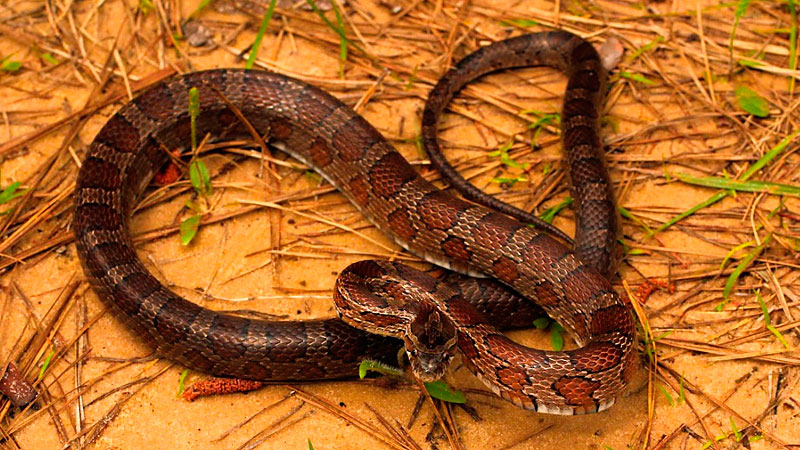
These typically have a light, grey background color with pale red or light-brown, saddle-shaped markings regularly spaced down their back. Their heads will have an arrow-shaped marking pointing towards the top of their snout, and they will have a thin dark stripe that extends from the top of the head and through the eye towards the back of the jaw. Their belly pattern will be mostly white with dark markings that resemble a checkerboard. This snake’s diet mostly consists of small birds and rodents, but they will occasionally eat lizards as well. This is a large constrictor that reaches an average length of 3 to 4 feet with a maximum length of 5 feet. Slowinski’s cornsnake is only found in west-central Louisiana and typically lives in long-leaf pine forest habitats. They are skilled climbers and are often found in trees searching for prey.
Red-bellied Mudsnake (Farancia abacura)
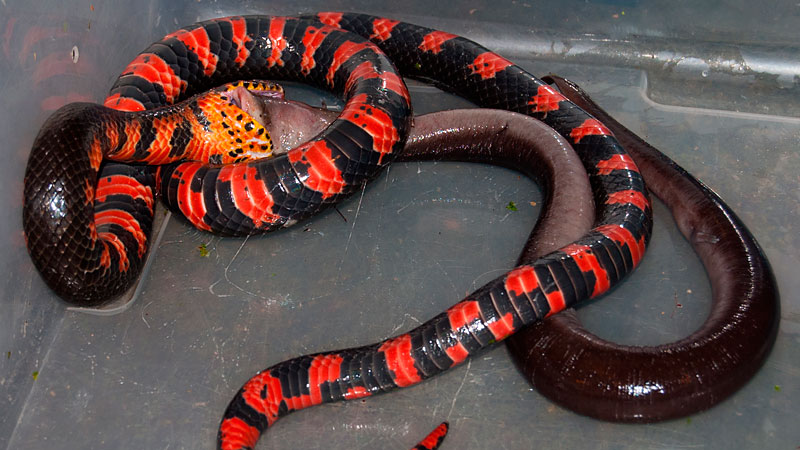
These beautiful snakes, distinguished by their vibrant red and black bellies with iridescent black back scales are rarely encountered alive because they’re mostly nocturnal. Mudsnakes have a diet consisting mostly of amphiumas (large salamanders often mistaken for eels), and they spend their lives in the mud of swamps and low wetlands as their name suggests. Adults average between 3 and 41/2 feet in length but with a record length of 811/2 inches. They are live-eaters and have acquired the nickname “the stinging snake” because the tip of their tails is very sharp to hold down slippery prey, so when grabbed, they will poke predators with their tail with the goal of being let go. There are eastern and western Mudsnakes; however, in Louisiana, we only have the western sub-species. Though they are found throughout the state, most people have only seen these guys dead on the road as they move at night and blend in with the asphalt. If you find one of these alive, please post some pictures on our Facebook page!
Graham’s Crayfish Snake (Regina grahamii)
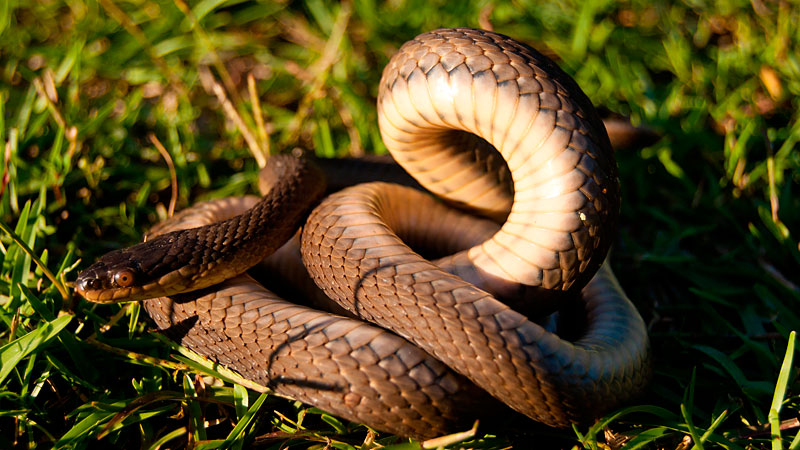
This relatively plain-looking species of snake is actually a very cool find. They are typically a medium brown or brownish-grey color with a light tan/yellow belly. They also have a distinct single row of black scales down the center of the belly. These guys are often confused with glossy swampsnakes, which we will cover in an upcoming article. Crayfish snakes are considered to be medium-sized and average 11/2 to 3 feet long with a record of 47 inches. As the name suggests — though the spelling may drive us Louisianans crazy — these live-eaters feed almost primarily on crawfish and prefer them to be freshly molted. If you find one, it will most likely be around a swamp, bayou or wetlands area. Their coloration allows for great camouflage while basking in the sun on branches and when slithering away in grass and leaves. They are found throughout the state but are mostly absent in the Florida parishes and the far west/central portion of Louisiana.
Speckled Kingsnake & Eastern Black Kingsnake (Lampropeltis holbrooki/Lampropeltis nigra)
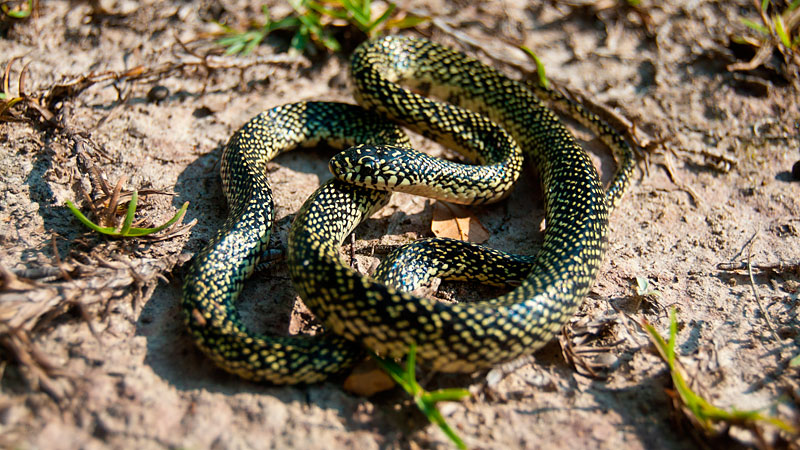
One of the most easily recognizable snakes in Louisiana is the speckled kingsnake. They are very visually distinct, with bright cream/white speckles covering their dark bodies. Juveniles appear to have stripes, but their bodies are so small that many of their speckles are closely located in rows that will spread apart as they grow and shed their skin. These constrictors eat countless rodents and even other snakes, including venomous ones, because they are immune to the venom. They don’t really have a specific type of habitat. I have seen them in all kinds of areas. Speckled kingsnakes are larger than some of our other native kingsnakes, as they average 3 to 4 feet long and have a record length of 6 feet. In Louisiana, we officially have speckled kingsnakes west of the Mississippi River and eastern black to the east, but they appear nearly identical.
Western Milksnake & Eastern Milksnake (Lampropeltis gentilis/Lampropeltis triangulum)
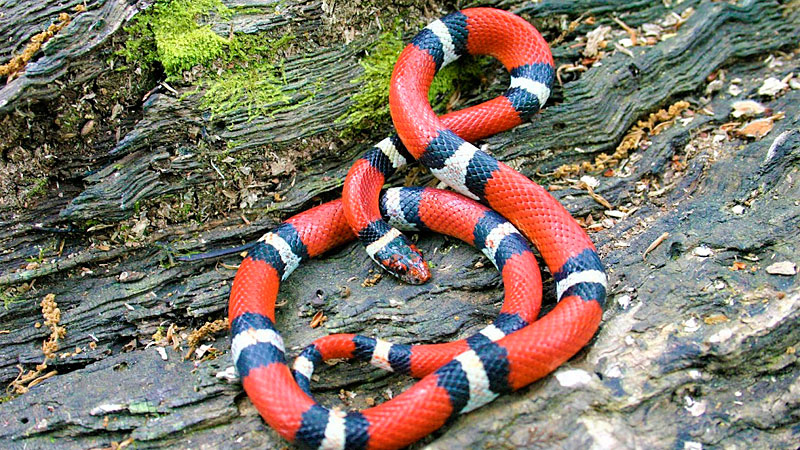
These snakes have alternating bands of red, black, and white/cream. The red bands are usually wider than the other colors and have a black band on each side. Those black bands then kind of sandwich the white bands between them. There is a white/yellow band around the back of the head, which is typically black, and sometimes they have white/cream spots on the nose. The belly is mostly yellow, or a pale orange or red, with the black bands extending onto it. Milksnakes, although small, grow to about 18 to 24 inches long. These constrictors often hide until nighttime, when they come out to eat lizards and small snakes. They’re found mostly in forests under the bark of dead trees, or inside of them, and under fallen logs. While there are a couple of exceptions in central Louisiana around Alexandria, and in north Louisiana around Monroe, western milksnakes are found mostly in the parishes bordering the Mississippi River and in those along our Texas border. The very similar eastern milksnakes are only found in the northeast corner of the state near Arkansas.
Prairie Kingsnake & Northern Mole Kingsnake (Lampropeltis calligaster & Lampropeltis rhombomaculata)
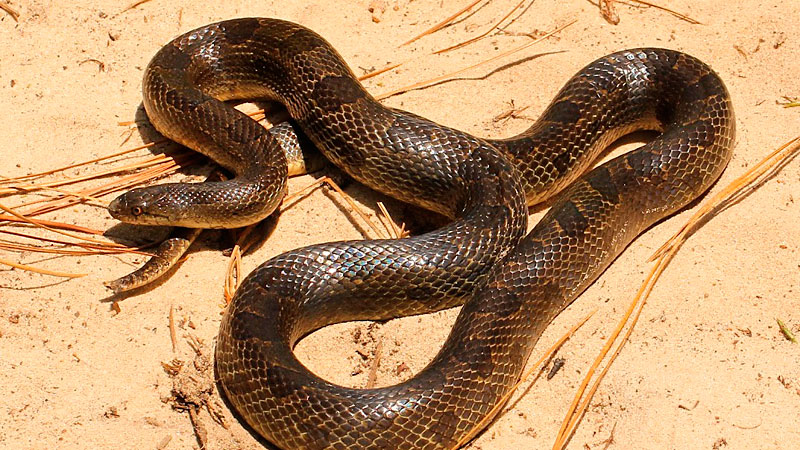
Prairie kingsnakes range from a light grey to a dark brown base color. Across the body are dark brown or black, irregular-shaped, oval-like spots that are regularly spaced down the back, and more smaller dark spots are along each side. The belly will usually be white with irregular black markings. Their pattern typically shows more of a contrast in colors as juveniles, and then darkens with size and age. They constrict rodents and lizards, and occasionally small snakes. These are larger snakes that typically reach 36 to 44 inches. Prairie kingsnakes are relatively secretive and spend much of their time underground in forests or open prairies. They live in most of the western half of the state, excluding the coast, and are typically found crossing a road or under logs and other cover objects. Because they’re closely related, I’ll briefly mention the northern mole kingsnake here, however this species has not been seen in Louisiana since the 1970s, so it is very unlikely that you will come across one.
Stay tuned next month for information on more of Louisiana’s amazing snakes. In the next article, we will be learning about the most common family of snakes you will come across in Louisiana; Watersnakes! Until then, don’t forget to check out www.louisianasnakeid.com for links to their social media, contact information and for lots of snake facts and fun. They can also be found at LA Snake Boyz on YouTube.